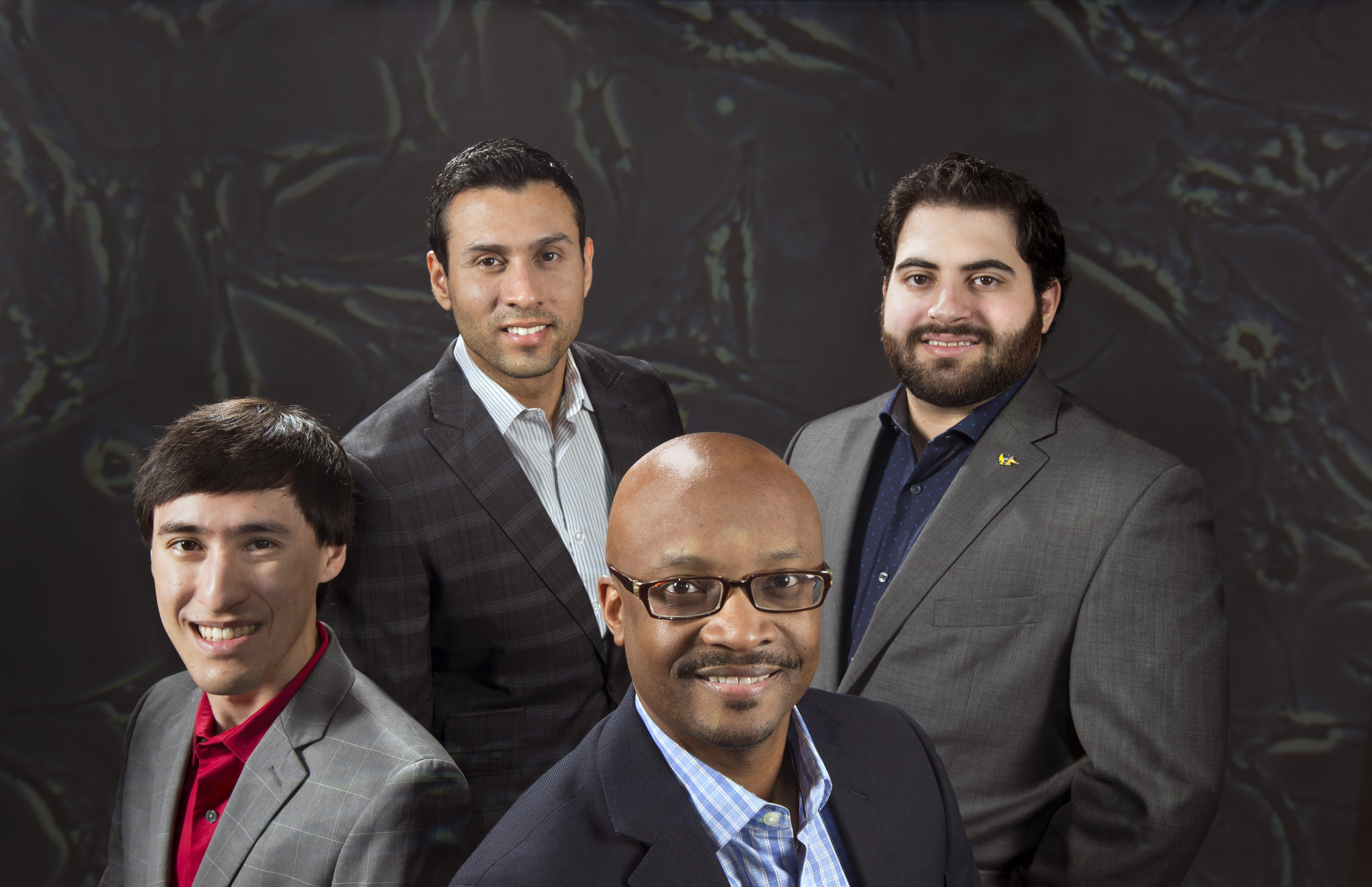Wound warriors
UCI alumni, doctor engineer potential stem cell treatment for diabetic foot ulcers

For Ahmed Zobi, it’s his mother. For Hugo Salas, a beloved grandmother. For Justin Stovner, a male relative who has endured 10 surgeries. For Dr. Derek Banyard, it’s his father and the largely African American patients whose limbs he’s had to amputate or who have died too young.
All have seen people they care for suffer from Type 2 diabetes. Together, the three recent UCI biomedical engineering graduates and the young physician with the UCI plastic surgery department’s Center for Tissue Engineering have co-founded a startup called Syntr Health Technologies. Their first goal? Perfecting a device to quickly and inexpensively process one’s own fat tissue into a potent tool to help heal dangerous foot ulcers.
Nearly 30 million diabetic Americans risk death because they can’t feel their feet. Nerve dysfunction and lack of circulation mean that an ingrown toenail or small cut can go undetected, leading to deeply infected wounds that linger for months. Skin substitutes can cost up to $9,000, and many patients are simply told to keep the area clean and stay off their feet – with often disastrous outcomes such as amputation. Half of those who lose a limb die within five years.
Syntr’s partners are aiming for a high-quality, effective solution at an affordable price. With their Syntrfuge technology, cells from a person’s own fat could be extracted, activated and re-injected near the damaged area in under an hour, spurring the growth of healthy new tissue.
“Did you know that diabetic foot ulcers can spread like wildfire from a single cut in a few weeks?” Zobi says. “Our hope is that we can catch the ulcer in time.”
The entrepreneurs already have patents pending worldwide for their Syntrfuge-based system, conceived during a senior-year class in 2015. As part of the BioENGINE program, the students had access to Applied Innovation and other UCI technology transfer centers and awards. They received a key National Institutes of Health grant last fall and are about to seek Food & Drug Administration clearance for testing. The project is emblematic of stepped-up efforts to turn stellar campus research into real-world products.
It’s not easy. After graduating in 2016, Zobi, 24, Salas, 36, and Stovner, 24, faced an important decision: Should they take $80,000-a-year engineering jobs or pass up steady employment to pursue their dream? They chose the latter. Together with Banyard, 37, they formed the company. Each has different survival strategies: living off credit cards, moving back in with parents, selling blood for cash, driving for Lyft and moonlighting at urgent-care clinics.
“We all could have gotten good jobs with industry straight out of college, but I decided to stay with this because I believe in it,” Stovner says. “I’ve wanted to invent something since high school, and I just want to contribute something to the world.”
Adds Salas: “We all wanted to make a medical contribution to society, not just go on to working for someone else.”
The undergraduates first came together because they knew they had compatible skill sets from earlier classes together. They identified promising intellectual property from Banyard’s research lab and bioengineering faculty and helped them solve a dilemma. Banyard and his colleagues had built on Belgian research showing that stem cells can be activated to function three to five times better than they normally would.
This “stressing” of fat stem cells is critical to jump-start them for regenerative healing purposes. To accomplish this, the biomedical and tissue engineers were trying to develop a pump system to aid cancer and diabetes treatments, but it was slow and prone to leaks. The students took over the project and instead created a leak-free spinning device on a CD to activate the cells. They had a prototype in about a month.
The team hasn’t slowed down since, winning numerous competitions and keeping up an eye-popping schedule of business pitching, online fundraising, product testing, grant writing and other tasks. They’ve refused to be knocked down by rejection, applying to the NIH three times before receiving a $300,000 award in October.
That was a huge milestone – not only do they have gas money now, but they’re in the door for possible larger federal or state stem cell funding in coming years. That would let them work with high-level experts and preserve equity in the company rather than giving it to private investors.
“I entered medicine to make a positive impact on society,” Banyard says. “To also start a profitable business would be icing on the cake.”
Besides cash, there are other challenges: Procuring fat cells from diabetics seeking cosmetic surgery – which are precisely the cells needed – is tough, even in image-conscious Orange County. The young executives are negotiating with an area veterans hospital and others. They’re starting in vivo testing and improving the aesthetics of their device, which was originally crafted with less than $100 worth of plastic and metal.
The team members are confident they’ll have a market-ready product to be used in hospitals and doctors’ offices within three years.
“Sure, everyone wants to be profitable, but we want to save lives,” Zobi says. “Diabetes is a horrible disease.”